PCBA First Article Inspection
Experience quality assurance with our First Article Inspection services. We guarantee flawless production and validate your processes to deliver results.
The Importance of First Article Inspection Process
First Article Inspections (FAI) is a quality control process conducted before mass production. It involves comprehensive examination and testing of the first piece, often a PCBA, to ensure compliance with specifications. First Article Inspection aims to identify potential issues early to prevent defective products during mass production. Engineers and quality control personnel verify documents, component installation, soldering and functional tests.
The First Article Inspection Mechanism is pivotal for PCBA manufacturing at Highleap. It checks components are installed correctly, solder joints for quality, and functional testing for electrical compliance. Only after passing First Article Inspection begins mass production, ensuring overall quality. This identifies issues early in design/production, before mass manufacturing, improving product quality and reliability. The First Article Inspection Mechanism thoroughly evaluates the first piece to help catch problems beforehand and optimize the production process.
- Preventing Batch Issues: The First Article Inspection mechanism helps in early detection and resolution of factors impacting product quality, thus preventing the occurrence of widespread defects or scrap in mass production.
- Mitigating Production Risks: By subjecting the initial few products to comprehensive testing before commencing mass production, it reduces the risk of incorrect products, enhancing process controllability.
- Applicability in Various Scenarios: First Article Inspection is typically conducted in scenarios such as the introduction of new products, the start or shift change of work shifts, product model changes, equipment and fixture adjustments, and process parameter modifications, making it adaptable to various production contexts.
- Three-Tiered Inspection System: Employing a system of self-inspection, mutual inspection, and specialist inspection ensures multi-level quality control, reducing the occurrence of errors and improving product compliance rates.
- Minimizing Rework and Scrap: Only products that pass the First Article Inspection proceed to full-scale production, thereby lowering the risk of producing non-compliant items, rework, and scrap.
- Enhancing Product Quality: First Article Inspection is a proactive control measure that helps identify and rectify potential issues early, elevating overall production quality.
- Cost-Effectiveness: Avoiding the occurrence of batch non-compliance saves significant costs and resources while also enhancing production efficiency and delivery reliability.
In summary, Highleap’s First Article Inspection mechanism in PCBA manufacturing is a critical quality control measure that reduces production risks, enhances product quality, reduces rework and scrap, thereby positively impacting the factory’s economic performance and reputation.
When is a FAI Necessary
First Article Inspections (FAI) plays a pivotal role, particularly in the initial stages of manufacturing a new product, ensuring that the manufacturing process is capable of producing products that adhere to specified requirements. It is essential to conduct a first article inspection when assessing one part, with the implicit assumption that all subsequent parts will follow the same production process.
This assumption is compromised when any of the following conditions arise, necessitating a new first article inspection:Factory Relocation, Alterations in the Manufacturing Process, Introduction of a New Product, Design Modifications.
Certain changes require a fresh FAI. For example, transitioning from laser cutting to stamping would necessitate a new FAI. Conversely, changes in how parts are packaged may not warrant a new first article inspection. FAI serves as an inspection tool that contributes to the establishment of a robust quality management system.

In summary, First Article Inspections (FAI) serve as a vital tool in ensuring product quality and compliance with specifications at Highleap. They are conducted whenever the manufacturing process or product undergoes significant changes that could impact quality or performance. FAI contribute to the establishment and maintenance of a robust quality management system within the manufacturing process at Highleap.
Highleap’s rigorous FAI process involves a full review of design documentation and thorough inspection and testing of the first production sample. This allows our quality assurance team to thoroughly validate all aspects of the design and production prior to sign-off for mass production. By implementing the FAI process, Highleap is able to identify any issues early on and make necessary corrections to our procedures to deliver the highest quality products to our customers.
Purpose of PCBA FAI
- To validate whether the PCB design complies with technical specifications and requirements. This includes verifying the correctness of the PCB layout and the appropriateness of component placements.
- To ensure that the assembly production line’s program settings are correct, such as the accurate loading of the correct component models by automated assembly machines and their precise placement.
- To inspect the initial assembled PCB board to confirm that it adheres to the design specifications. This involves checking the completeness of component soldering and the quality of solder joints.
- To conduct basic performance tests on the assembled PCB board, including functions like key responsiveness, interface logic testing, etc., to verify the proper functioning of essential features.
- To proactively identify potential issues in the production process, encompassing PCB design and assembly program settings, before the commencement of bulk production.
- To validate the reliability and controllability of the production process, ensuring consistent quality levels in subsequent mass production runs.
- To serve as the quality benchmark for subsequent large-scale production, guaranteeing that the quality of PCBs manufactured in the future remains in line with the standards established during the First Article Inspection.
In summary, the purpose of PCBA First Article Inspection is to detect issues during the small-scale trial production phase, ensuring the quality and performance of subsequent mass production, and establishing a foundation for product quality control.
The importance of Automation Inspection
Automation inspection ensures consistency in inspection results. Human inspectors may vary in their judgment and attention to detail, leading to inconsistencies in the quality control process. Automated inspection systems, on the other hand, follow predefined algorithms and criteria meticulously, providing consistent and objective results every time. This consistency is vital in industries where product quality and compliance with standards are paramount, such as electronics manufacturing, pharmaceuticals, and aerospace.Here’s a comparison of the risks in traditional first article inspection versus automating the inspection process:
The Risks of Traditional First Article Inspection
- Operators may accidentally load the wrong parts, reversed or skewed, or miss parts, leading to rework and delays.
- Inadequate documentation: Incomplete or inaccurate documentation can lead to confusion and errors in the inspection process.
- Manual errors: Manual inspection processes can be error-prone, and operators may miss critical components or incorrectly identify parts.
- Inefficient process: The traditional inspection process can be slow and inefficient, taking up to 3 hours to inspect all parts on a PCB containing 300-400 SMD components.
- Quality issues: Traditional inspection methods may not be able to detect certain quality issues, such as defects in the soldering process or incorrect component orientation.

The Risks of Automate the Inspection Process
- Initial investment: Automating the inspection process may require an initial investment in equipment and software.
- Programming errors: If the automated inspection system is not programmed correctly, it may not detect certain defects or incorrectly identify components.
- Limited flexibility: Automated inspection systems may not be able to adapt to changes in the production process or new component designs.
- Maintenance: Automated inspection systems require regular maintenance to ensure optimal performance.
- Dependence on technology: Automated inspection systems rely on technology and may be vulnerable to technical issues or software glitches.

Advantages of Automating Inspection Process
1. Increased accuracy: Automated inspection systems can inspect PCBs faster and more accurately than manual methods, reducing the risk of errors and defects.
2. Improved efficiency: Automated inspection systems can inspect all parts on a PCB in a matter of minutes, significantly reducing the time required for inspection.
3. Adaptability: Automated inspection systems can adapt to changes in production processes and component designs by updating software and programming.
4. Reduced labor costs: Automated inspection systems can reduce the need for manual labor, saving time and resources.
5. Improved quality: Automated inspection systems can detect defects that may not be visible to the human eye, improving the overall quality of the final product.
6. Real-time monitoring: Automated inspection systems can provide real-time monitoring of the inspection process, allowing for quick identification and resolution of issues.
7. Data analysis: Automated inspection systems can collect and analyze data on the inspection process, providing valuable insights for process improvement.
8. Reduced rework: Automated inspection systems can reduce the need for rework by detecting defects early in the production process.
9. Improved customer satisfaction: Automated inspection systems can improve customer satisfaction by ensuring high-quality products and reducing the risk of defects.
By comparing the risks of traditional first article inspection versus the advantages of automating the inspection process, it’s clear that automating the inspection process can bring significant benefits to PCB assembly manufacturers. However, it’s important to carefully consider the initial investment costs and ensure that the automated system is properly programmed and maintained to minimize risks and maximize benefits.
First article inspection (FAI) keywords
- The initial examination of the first product in a production run to ensure it meets specified requirements.
- PCBA FAI: An acronym for “PCB Assembly First Article Inspection,” it refers to the process of inspecting the first PCB assembly.
- PCB assembly inspection: The act of examining the assembled printed circuit board to verify its correctness and quality.
- FAI process: The systematic procedure for conducting First Article Inspections, which includes documentation, inspection, and validation.
- Manufacturing quality control: Measures taken to maintain consistent and high-quality manufacturing processes.
- PCBA quality assurance: Methods and practices implemented to ensure the quality and reliability of PCB assembly.
- Initial production inspection: The inspection conducted at the beginning of a production run to identify and rectify potential issues.
- PCB design validation: The process of confirming that the PCB design aligns with specified technical requirements.
- Component placement verification: Checking the correct positioning of components on the PCB during assembly.
- Assembly process validation: Confirming that the assembly process is correctly configured and adheres to established standards.
- Quality benchmarking: Establishing a standard of quality against which products are compared.
- PCB layout verification: Ensuring that the physical layout of the PCB matches the design.
- Solder joint quality: Assessing the integrity and quality of soldered connections on the PCB.
- Performance testing: Evaluating the PCB’s functionality and operational capabilities.
- Manufacturing process reliability: Ensuring that the manufacturing process is consistent, stable, and dependable.
- Quality standards: The defined criteria and specifications that products must meet to be considered of high quality.
- Production readiness: The state of preparedness for large-scale production following initial testing and inspection.
- Quality control in PCB assembly: The practices and processes employed to maintain PCB assembly quality.
- FAI report: A document summarizing the results and findings of a First Article Inspection.
- Compliance verification: Ensuring that the PCB assembly complies with industry standards and specifications.
